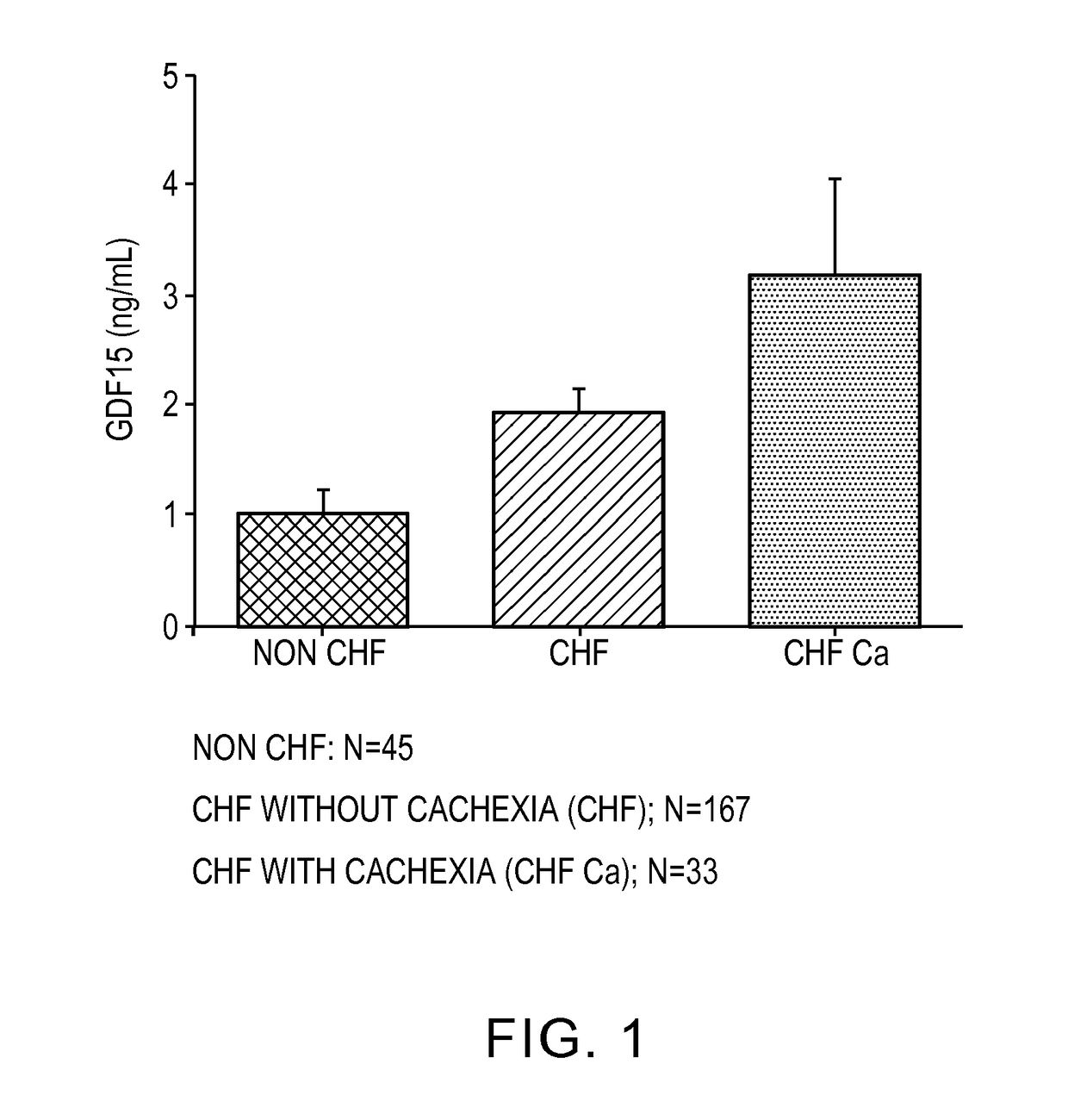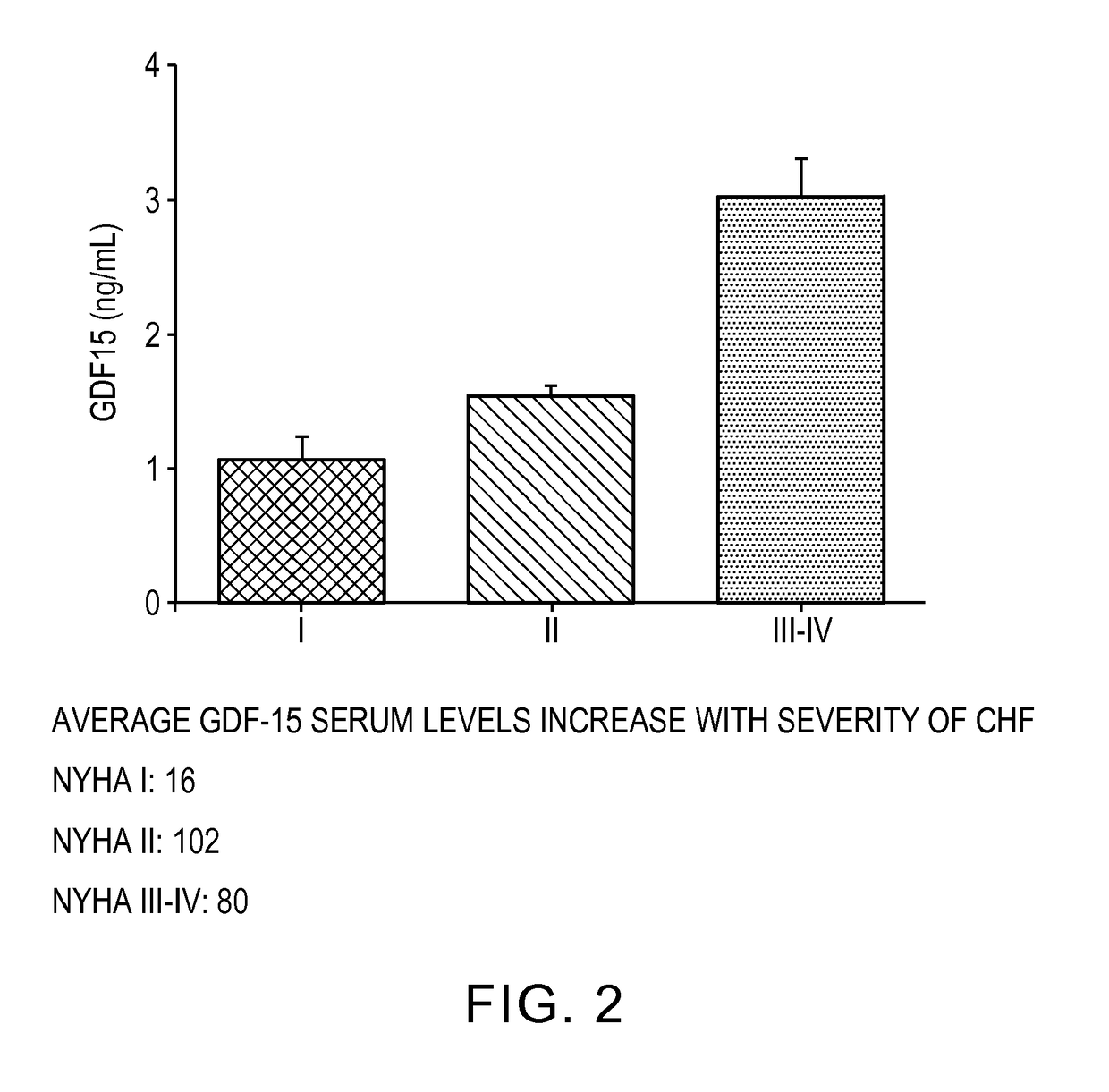Treatment of congestive heart failure and other cardiac dysfunction using a gdf15 modulator
a technology of congestive heart failure and modulator, which is applied in the field of gdf15 modulator, can solve the problems of heart muscle becoming unable to efficiently pump blood around the body, high debilitating and potentially lethal condition, and hospitalization, and achieves the effect of effectively or optimal treatment, reducing or inhibiting the activity of gdf15, and reducing the expression, level or amount of gdf15
- Summary
- Abstract
- Description
- Claims
- Application Information
AI Technical Summary
Benefits of technology
Problems solved by technology
Method used
Image
Examples
example 1
GDF15 Levels in Subjects With and Without Congestive Heart Failure
[0138]Samples of plasma from 245 subjects were examined, and the results are summarized in FIGS. 1-6. GDF15 was assessed at a 1:50 plasma dilution with the DuoSet ELISA Development Kit (R&D Systems, #DY957) according to the manufacturer's recommendation. The inter-assay coefficient of variation (CV) was 5.6%, and the intra-assay CV was 2.9%.
[0139]It was discovered that GDF15 levels were significantly higher in subjects who had been diagnosed with CHF (n=200; mean of about 1900 pg / ml GDF15 for CHF without cachexia; mean of about 3000 pg / ml GDF15 for CHF with cachexia) than in those who were not (n=45; mean of about 1000 pg / ml) (FIG. 1). GDF15 levels were significantly higher in subjects with CHF regardless of whether they presented with cachexia co-morbidity (n=33; mean of about 3000 pg / ml GDF15) or not (n=167; mean of about 1900 pg / ml GDF15) (FIG. 1). Average GDF15 levels increased with increased severity of CHF (FIG....
example 2
Treatment of Cardiac Hypotrophy in an HT-1080 Xenograft Tumor Model
[0144]This Example demonstrates the treatment of cardiac hypotrophy (as indicated by heart weight loss) with an anti-GDF15 antibody 01G06 in an HT-1080 fibrosarcoma xenograft model.
[0145]HT-1080 cells were grown in culture at 37° C. in an atmosphere containing 5% CO2, using Eagle's Minimum Essential Medium (ATCC, Catalog No. 30-2003) containing 10% FBS. Cells were inoculated subcutaneously into the flank of 8-week old female ICR SCID mice with 5×106 cells per mouse in 50% matrigel. Body weight was measured daily. When body weight reached 80%, the mice were randomized into two groups of five mice each. Each group received one of the following treatments: murine IgG control (“mIgG”), or 01G06 dosed at 2 mg / kg on day 1 and day 7, via intra-peritoneal injection. Treatment with antibody 01G06 resulted in body weight increase to initial weight or 100% (p<0.001) (FIG. 7A).
[0146]The data in FIGS. 7A-B indicate that administr...
example 3
In vivo Model of Pressure-Induced Cardiac Hypertrophy
[0150]A reproducible transverse aortic constriction of 65-70% is made in mice, as described in Rockman et al., 1991, PROC. NATL ACAD. SCI., 88:8277-8291. The animals are extubated and allowed to recover, and blood pressure in the left and right carotids is measured. Animals then are dosed with either an anti-GDF15 antibody or control. After seven days, heart size and weight are assessed for the existence and / or extent of cardiac hypertrophy.
PUM
| Property | Measurement | Unit |
|---|---|---|
| Fraction | aaaaa | aaaaa |
| Density | aaaaa | aaaaa |
| Density | aaaaa | aaaaa |
Abstract
Description
Claims
Application Information
 Login to View More
Login to View More - R&D
- Intellectual Property
- Life Sciences
- Materials
- Tech Scout
- Unparalleled Data Quality
- Higher Quality Content
- 60% Fewer Hallucinations
Browse by: Latest US Patents, China's latest patents, Technical Efficacy Thesaurus, Application Domain, Technology Topic, Popular Technical Reports.
© 2025 PatSnap. All rights reserved.Legal|Privacy policy|Modern Slavery Act Transparency Statement|Sitemap|About US| Contact US: help@patsnap.com



